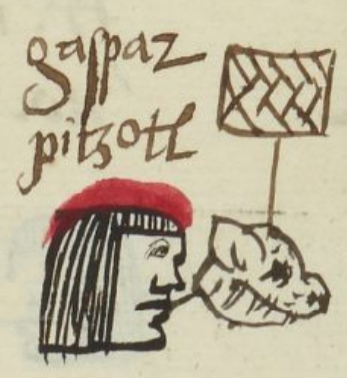Pitzotl (MH499v)
This black-line drawing of the simplex glyph for the personal name Pitzotl ("Peccary," attested here as a man's name) shows the head of a peccary (pitzotl) in profile, facing the viewer’s right. Sharp teeth seem to protrude from the mouth. The animal's coat has some texturing. The animal looks more like a jaguar than a peccary .
Stephanie Wood
Another pitzotl is found on MH folio 569 verso, and this one has a flat nose more like a pig. Juan José Batalla Rosado (2018, 110) suggests that this looks nothing like a pig and if it were not for the gloss we might analyze it differently. Pigs were a European introduction to the Americas, although there were some similar animals, such as the pizote, cuchuche, tejón americano, soncho, zorro juache o cuatl (Batalla, citing Lockhart 1999, 404, note 46). And see below for the coyametl. Here, the man who has the name Gaspar Pitzotl is a maker of woven mats, as can be seen in the contextualizing image. So, pig-raising is not his occupation.
Stephanie Wood
gaspar
pitzotl
Gaspar Pitzotl
Stephanie Wood
1560
Jeff Haskett-Wood
pigs, puercos, cochinos, cerdos, nombres de hombres

pitzo(tl), pig, https://nahuatl.wired-humanities.org/content/pitzotl
El Cerdo
Stephanie Wood
Matrícula de Huexotzinco, folio 499v, World Digital Library, https://www.loc.gov/resource/gdcwdl.wdl_15282/?sp=78&st=image
This manuscript is hosted by the Library of Congress and the World Digital Library; used here with the Creative Commons, “Attribution-NonCommercial-ShareAlike 3.0 License” (CC-BY-NC-SAq 3.0).



